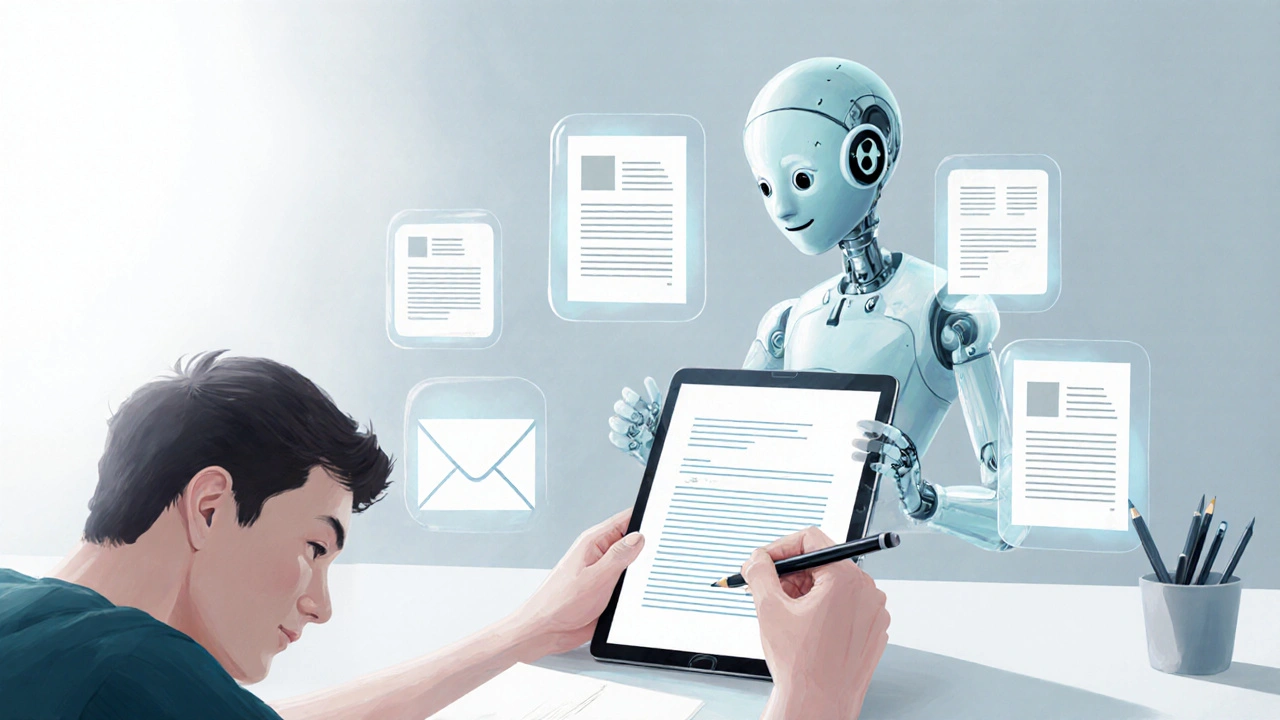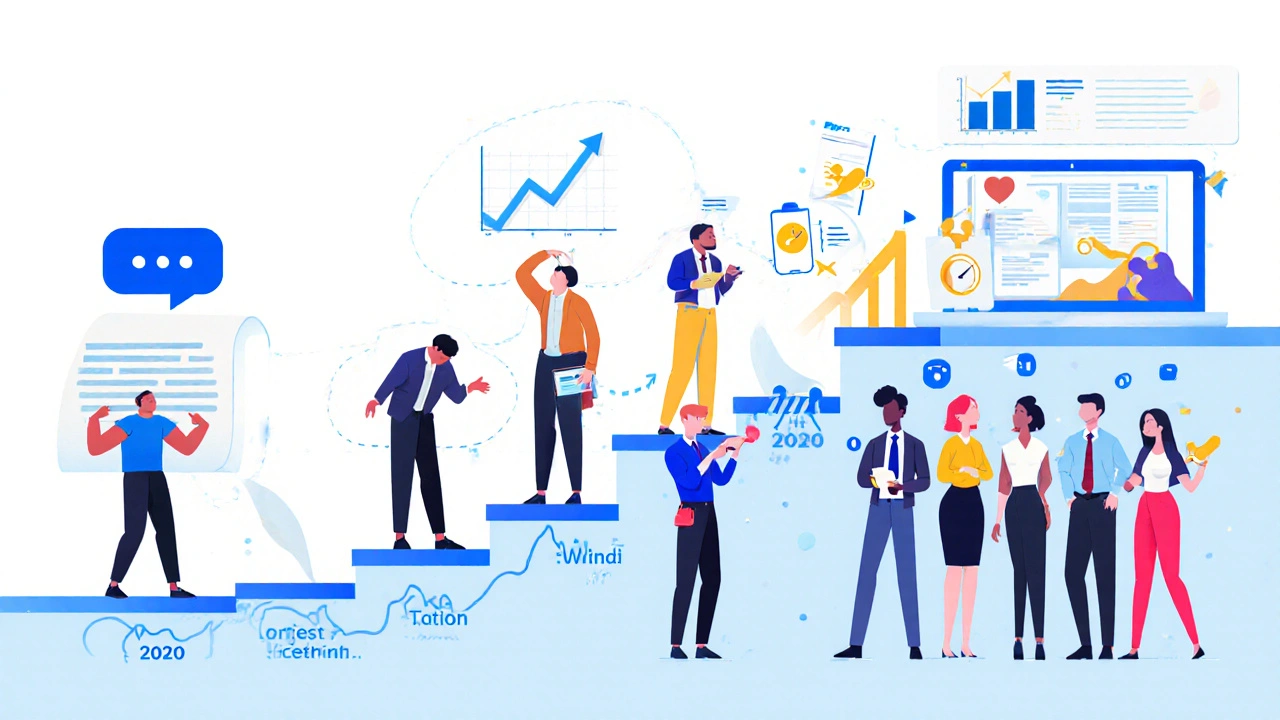ChatGPT: The Game Changer in Content Generation

Content Creation Time Savings Calculator
How much time does your content creation take?
Calculate your potential time savings using ChatGPT. Based on real data from 2025 marketing reports showing 40-70% time reduction.
Five years ago, writing a blog post took hours. You’d stare at a blank screen, research three sources, rewrite three drafts, and still feel like it sounded robotic. Today, you type a prompt into ChatGPT and get a polished draft in under a minute. That’s not an upgrade-it’s a revolution.
How ChatGPT Changed the Rules of Content Creation
Before ChatGPT, content generation meant hiring writers, outsourcing to freelancers, or grinding through hours of research and writing. Even the best tools back then-Grammarly, Hemingway, or basic templates-only helped polish what you already wrote. They didn’t create.
ChatGPT changed that. It doesn’t just fix grammar. It writes full articles, product descriptions, email sequences, and social posts from scratch. It learns from your tone, matches your brand voice, and adapts to your audience. A small business owner in Omaha can now produce content that sounds like it came from a professional marketing team-without paying for one.
According to a 2025 survey by Content Marketing Institute, 68% of marketers now use generative AI like ChatGPT as their first draft tool. That’s up from 12% in 2021. The shift wasn’t gradual. It was explosive.
What Makes ChatGPT Different From Other Tools?
There are dozens of AI writing tools out there. Jasper, Copy.ai, Writesonic-they all promise the same thing. But ChatGPT stands out because it’s not just a content machine. It’s a conversation partner.
Most tools require you to pick a template: “Blog post,” “Product description,” “Ad copy.” You fill in blanks. ChatGPT lets you say: “Write a 700-word guide for new parents on choosing baby formula, using a calm, trustworthy tone. Avoid jargon. Mention three brands but don’t promote any.” And it does it. No templates. No rigid structures.
It also remembers context. If you ask it to rewrite a paragraph three times, it doesn’t forget what you liked or disliked. You can say, “Make it shorter,” “Add more data,” or “Sound more like a doctor, not a salesperson.” It adjusts. That level of flexibility is why so many content teams now use ChatGPT as their co-writer, not just a replacement.

Real Examples: Where ChatGPT Actually Works Best
Not every piece of content benefits from AI. Some things still need a human touch-like emotional storytelling or nuanced opinions. But here’s where ChatGPT shines:
- Product descriptions for e-commerce: A Shopify store owner selling handmade candles used ChatGPT to generate 200 unique product descriptions in two hours. Each one included scent notes, burn time, and emotional appeal. Sales rose 22% in four weeks.
- SEO blog outlines: A freelance writer in Austin uses ChatGPT to turn a keyword like “best budget running shoes 2025” into a full outline with H2s, H3s, and bullet points backed by recent data. She then writes the final draft-faster, with better structure.
- Email newsletters: A SaaS company reduced their email drafting time from 3 hours per week to 45 minutes. ChatGPT drafts subject lines, body copy, and even A/B test variations based on past open rates.
- Local business content: A dentist in Boston uses ChatGPT to write blog posts like “What to Expect During Your First Root Canal” or “How to Stop Teeth Grinding at Night.” These posts now rank on page one of Google, bringing in 30 new patient inquiries a month.
These aren’t hypotheticals. These are real results from users who stopped fighting the tool and started partnering with it.
The Hidden Downsides Nobody Talks About
ChatGPT isn’t magic. And pretending it is will hurt your content.
First, it hallucinates. It makes up facts. A user once asked for “FDA-approved weight loss supplements in 2025” and got a list of five-three of which don’t exist. If you copy-paste without checking, you risk legal trouble and lost trust.
Second, it sounds generic. Left unchecked, ChatGPT defaults to safe, bland language. You’ll get paragraphs that sound like every other AI-generated article: “In today’s fast-paced world…” “Unlock your potential…” “Take the next step.”
Third, over-reliance kills creativity. If you let ChatGPT write everything, your team stops thinking critically. You lose your unique voice. Your content becomes indistinguishable from every other brand using the same tool.
The fix? Always edit. Always fact-check. Always add your own perspective. Use ChatGPT as your assistant, not your author.

How to Use ChatGPT Without Losing Your Brand Voice
You don’t need to be a tech expert to use ChatGPT well. Here’s how real teams do it:
- Give it a style guide: Paste 2-3 of your best blog posts into the prompt. Say: “Write in this tone and style.” It learns faster than any template.
- Use it for drafts, not final copy: Treat every output as a rough draft. Rewrite the intro. Add a personal story. Include a real quote or data point.
- Inject specificity: Instead of “Write a blog post about productivity,” say “Write a blog post about how I got 10 hours back in my week by cutting meetings in half-using only free tools.”
- Run it through a human filter: Have someone who knows your brand read the output. Does it sound like you? If not, rewrite it.
One content team at a mid-sized agency in Chicago started using this method. Their bounce rate dropped 31% in three months. Why? Because their content finally sounded human again-even though 90% of it started with AI.
What’s Next for AI in Content?
ChatGPT isn’t the end-it’s the beginning. Tools are already getting better. Some can now generate images to go with your text. Others can record voiceovers. A few even analyze your top-performing content and suggest new topics based on audience behavior.
But the biggest shift isn’t technical. It’s cultural. Companies that treat AI as a shortcut are falling behind. Those that treat it as a co-pilot are scaling faster than ever.
In 2025, the best content teams aren’t the ones using the most AI. They’re the ones using AI the smartest. They know when to let it write, when to edit it, and when to throw it away and write it themselves.
The game changer isn’t ChatGPT. It’s how you use it.
Can ChatGPT replace human content writers?
No-not completely. ChatGPT can generate drafts quickly, but it can’t replicate human insight, emotional depth, or original storytelling. The best results come from collaboration: use AI to handle research and structure, then let humans add personality, context, and authenticity. Writers who use ChatGPT as a tool are more productive. Writers who replace themselves with it risk losing their voice and credibility.
Is content created by ChatGPT good for SEO?
Yes, if it’s well-edited. Google doesn’t penalize AI-generated content outright. What it does penalize is low-quality, repetitive, or misleading content-whether it’s written by a human or an AI. ChatGPT can help you write clear, keyword-rich, structured content that ranks. But you still need to fact-check, add unique value, and ensure it meets user intent. The most successful SEO content today combines AI speed with human expertise.
How much time can ChatGPT save on content creation?
Most users report saving 40-70% of their writing time. For example, drafting a 1,000-word blog post used to take 3-4 hours. With ChatGPT, the first draft takes 10-15 minutes. But don’t forget editing time. A polished final version usually takes another 30-60 minutes. Still, that’s a 50%+ time reduction. For teams producing 20+ pieces a month, that’s dozens of hours saved every week.
Does ChatGPT work for niche industries like healthcare or finance?
Yes, but with caution. In regulated industries, accuracy is non-negotiable. ChatGPT can generate draft content on topics like “how to manage cholesterol” or “tax deductions for freelancers,” but it often gets details wrong. Always verify facts with official sources-CDC, FDA, IRS, etc. Use AI to speed up research and structure, but never skip compliance review. Many healthcare marketers now use ChatGPT to draft content, then have their legal or compliance team review it before publishing.
What’s the best way to get started with ChatGPT for content?
Start small. Pick one type of content you write often-like product descriptions or social media captions. Write a clear prompt: “Generate 5 Instagram captions for our organic skincare line, focused on natural ingredients and calm, minimalist tone.” Test the output. Edit it. Compare it to your old posts. If it’s better or faster, use it again. Slowly expand to other types. Track your time savings and engagement metrics. You don’t need to overhaul your workflow overnight. Just make one task easier.



